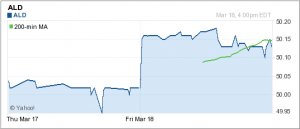With interest rates hovering at all time lows, the generation of income remains a problem for many investors. Let’s take a look at “Wisdom Tree Launches Asia Debt ETF (ALD):”
Thursday marks the first day of trading for the WisdomTree Asia Local Debt Fund (ALD), an actively-managed ETF offering exposure to debt of a dozen developed and emerging Asia Pacific countries. The fund will invest primarily in local currency debt from issuers in South Korea, Indonesia, Malaysia, Singapore, Hong Kong, China, India, Thailand, Philippines, and Taiwan, as well as the developed markets of Australia and New Zealand. ALD will implement a tiered investment approach, with markets deemed to maintain larger and more liquid debt markets receiving higher weightings in the fund. A single country cap of 20% will be applied.
ALD will be the first ETF focusing specifically on debt of Asian issuers, joining only a handful of products offering broad exposure to non-U.S. fixed income investments. Existing products in the International Government Bonds ETFdb Category focus primarily on Western Europe and Japan; the same is true for international corporate bond funds offered by PowerShares and State Street (PICB and IBND). The new fund launched with close to $145 million in assets, highlighting the tremendous interest in the asset class. Most new exchange-traded products debut with seed capital between $3 million and $10 million.
WisdomTree also offers CEW, a more broad-based fund offering exposure to local currency-denominated debt of emerging markets in Asia, Eastern Europe, and South America. Van Eck (EMLC) and State Street (EBND) also offer emerging market bond ETFs focusing on local currency debt, while products from iShares (EMB) and PowerShares (PCY) invest in dollar-denominated bonds.
A wave of new products in the last several years has delivered ETF options for targeting specific sectors and durations of the U.S. bond market. But ETF options for fine tuning international fixed income exposure are still relatively limited; ALD offers a new degree of precision. There are a number of challenges associated with developing efficient products in this asset class, including diversification requirements of the Investment Company Act of 1940 and liquidity risks associated with the underlying securities. The fact that ALD is actively managed gives it flexibility in various areas, allowing the creation of a vehicle that offers exposure to Asian bonds.
…
Yield Enhancer?
With U.S. interest rates hovering near record lows and expected to remain depressed for the foreseeable future, ALD could have appeal for investors seeking to enhance the current yield of their fixed income portfolio. The Barclays 3-7 Year Treasury Bond Fund (IEI) recently had a 30-day SEC yield of under 2%. The comparable yield for Vanguard’s Intermediate-Term Corporate Bond ETF (VCIT) was about 4.2%. ALD, which will maintain an aggregate portfolio duration between two and eight years, maintained a weighted average coupon of about 4.2% on launch.
The new Asia bond fund could also have appeal for investors simply looking to diversify their fixed income holdings. Beyond the aforementioned lack of targeted options in the ETF lineup, many world bond mutual funds are tilted heavily towards Europe and Japan. ALD presents another opportunity for gaining exposure to many of the world’s most promising emerging markets, potentially complementing existing equity and currency products. And ALD of course will provide an opportunity for investors to diversify dollar exposure, gaining access to currencies of several Asian economies.
[Emphasis added]This ETF is brand new, so the above 2-day chart is not indicative of any trend. While a 4.2% yield is certainly enticing, I like to see at least 9 months of data to better identify and judge directional behavior.
As with equities, you don’t want to be caught when this ETF slips below its long-term trend line. For bond ETFs/funds, that is very likely a sign that we have entered an environment of higher rates, and you could be losing more on the principal than you are gaining in dividends.
From the above mentioned ETFs, IEI and VCIT, only VCIT has moved above its long-term trend line, and therefore can be considered a buy. In today’s volatile market environment, facts can change in a hurry, which is why I apply a 5% trailing stop loss for bond ETFs/funds. I suggest you do the same—it’s better to be safe than sorry.
Disclosure: No holdings
Above chart courtesy of YahooFinance
Contact Ulli

Comments 2
Hi Ulli
Any thoughts on the Wisdom Tree Managed Futures Fund? Could they serve as hedge against falling dollar and rising commodities?
Mal
Mal,
What is the ticker symbol?
Ulli…